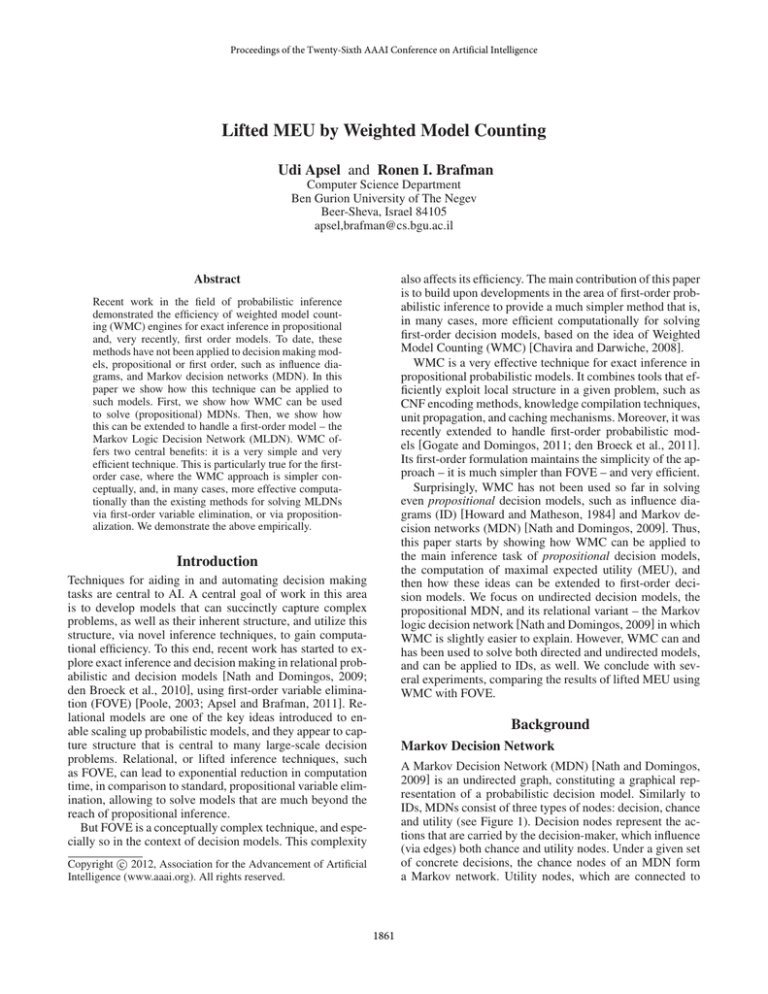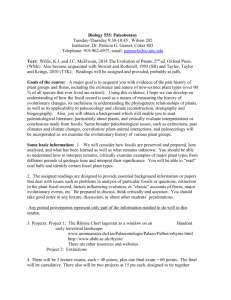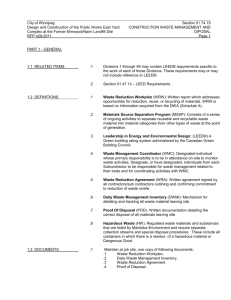
Proceedings of the Twenty-Sixth AAAI Conference on Artificial Intelligence
Lifted MEU by Weighted Model Counting
Udi Apsel and Ronen I. Brafman
Computer Science Department
Ben Gurion University of The Negev
Beer-Sheva, Israel 84105
apsel,brafman@cs.bgu.ac.il
Abstract
also affects its efficiency. The main contribution of this paper
is to build upon developments in the area of first-order probabilistic inference to provide a much simpler method that is,
in many cases, more efficient computationally for solving
first-order decision models, based on the idea of Weighted
Model Counting (WMC) [Chavira and Darwiche, 2008].
WMC is a very effective technique for exact inference in
propositional probabilistic models. It combines tools that efficiently exploit local structure in a given problem, such as
CNF encoding methods, knowledge compilation techniques,
unit propagation, and caching mechanisms. Moreover, it was
recently extended to handle first-order probabilistic models [Gogate and Domingos, 2011; den Broeck et al., 2011].
Its first-order formulation maintains the simplicity of the approach – it is much simpler than FOVE – and very efficient.
Surprisingly, WMC has not been used so far in solving
even propositional decision models, such as influence diagrams (ID) [Howard and Matheson, 1984] and Markov decision networks (MDN) [Nath and Domingos, 2009]. Thus,
this paper starts by showing how WMC can be applied to
the main inference task of propositional decision models,
the computation of maximal expected utility (MEU), and
then how these ideas can be extended to first-order decision models. We focus on undirected decision models, the
propositional MDN, and its relational variant – the Markov
logic decision network [Nath and Domingos, 2009] in which
WMC is slightly easier to explain. However, WMC can and
has been used to solve both directed and undirected models,
and can be applied to IDs, as well. We conclude with several experiments, comparing the results of lifted MEU using
WMC with FOVE.
Recent work in the field of probabilistic inference
demonstrated the efficiency of weighted model counting (WMC) engines for exact inference in propositional
and, very recently, first order models. To date, these
methods have not been applied to decision making models, propositional or first order, such as influence diagrams, and Markov decision networks (MDN). In this
paper we show how this technique can be applied to
such models. First, we show how WMC can be used
to solve (propositional) MDNs. Then, we show how
this can be extended to handle a first-order model – the
Markov Logic Decision Network (MLDN). WMC offers two central benefits: it is a very simple and very
efficient technique. This is particularly true for the firstorder case, where the WMC approach is simpler conceptually, and, in many cases, more effective computationally than the existing methods for solving MLDNs
via first-order variable elimination, or via propositionalization. We demonstrate the above empirically.
Introduction
Techniques for aiding in and automating decision making
tasks are central to AI. A central goal of work in this area
is to develop models that can succinctly capture complex
problems, as well as their inherent structure, and utilize this
structure, via novel inference techniques, to gain computational efficiency. To this end, recent work has started to explore exact inference and decision making in relational probabilistic and decision models [Nath and Domingos, 2009;
den Broeck et al., 2010], using first-order variable elimination (FOVE) [Poole, 2003; Apsel and Brafman, 2011]. Relational models are one of the key ideas introduced to enable scaling up probabilistic models, and they appear to capture structure that is central to many large-scale decision
problems. Relational, or lifted inference techniques, such
as FOVE, can lead to exponential reduction in computation
time, in comparison to standard, propositional variable elimination, allowing to solve models that are much beyond the
reach of propositional inference.
But FOVE is a conceptually complex technique, and especially so in the context of decision models. This complexity
Background
Markov Decision Network
A Markov Decision Network (MDN) [Nath and Domingos,
2009] is an undirected graph, constituting a graphical representation of a probabilistic decision model. Similarly to
IDs, MDNs consist of three types of nodes: decision, chance
and utility (see Figure 1). Decision nodes represent the actions that are carried by the decision-maker, which influence
(via edges) both chance and utility nodes. Under a given set
of concrete decisions, the chance nodes of an MDN form
a Markov network. Utility nodes, which are connected to
c 2012, Association for the Advancement of Artificial
Copyright Intelligence (www.aaai.org). All rights reserved.
1861
Algorithm 1: bwmc(C)
input : CNF C with assigned weights
output: WMC of C
1
2
3
4
Figure 1: A Markov decision network (MDN)
chance and decision nodes only, are real value functions
over the scope of the connected nodes. The task of solving an MDN is synonymous with finding the set of decisions which maximizes the expected utility. In this paper,
we define the properties of an MDN using a set of weighted
propositional formulas. Hence, the table entries of utility and
probability factors are depicted by weights, corresponding
to a propositional
S formula. Formally, an MDN M is a set of
triples M = i (fi , φi , µi ), where fi is a propositional formula over decision variables dv(M ) and random variables
rv(M ), φi ∈ R+
0 is a probability weight and µi ∈ R is
a utility weight. A formula fi whose respective φi =
6 1 is
called a probability formula (PF), and a formula fj whose
respective µj 6= 0 is called a utility formula (UF). It is possible for a formula to be both PF and UF. As a convention,
we use the notation ϕ|τ to depict the expression ϕ under the
assignment τ , namely (x2 + y)|x=2 equals 4 + y. Under a
set of assignments d to all decision variables, the expected
utility of M is given by
X
Y
X
1
eu[M |d ] =
·
φi |d,r
µi |d,r (1a)
Z|d
i
i
Algorithm 1 depicts a basic WMC algorithm (bwmc), which
is directly derived from the WMC definition. Since probabilistic queries in both Bayesian and Markov networks can
be redefined as WMC tasks, WMC algorithms have been
extensively studied in recent years [Chavira and Darwiche,
2008]. The general framework requires (a) a conversion of
the probabilistic model to a set of weighted propositional
formulas, (b) distributing weights to all variables for positive and negative assignments, (c) assembling all formulas
to a single CNF formula, and (d) running the WMC engine. State-of-the-art engines incorporate a more sophisticated version of the basic WMC, along with a set of tools
for caching [Sang, Beame, and Kautz, 2005], knowledge
compilation [Huang and Darwiche, 2005] and simplifying
the CNF by unit propagation [Li and Anbulagan, 1997]. Our
aim here is to show how to exploit the existing framework
and set of tools for the benefit of EU computation. We do so
by redefining the EU computation in MDNs as a WMC task.
Expected Utility as WMC
r∈range(rv(M ))
Where
X
Z|d =
Y
φi |d,r
S
Given MDN M = i (fi , φi , µi ) and a set of assignments d
to all decision variables, we seek to compute
Veu[M |d ]. First,
we construct a CNF formula C = CN F { i (fi |d ⇔ si )}.
The si elements are newly added variables, which indicate whether a formula fi is satisfied. We use the notation
vars(C) to depict the set of all unassigned variables in CNF
C. Second, we distribute weights to all unassigned variables in C (namely, non-decision variables). Unlike classical WMC, a weight w is defined as a pair w = (φ, µ),
where φ and µ are probability and utility components, respectively. We provide a weight w¬x = (1, 0) to each variable x in C, a weight wx = (1, 0) to all random variables,
and a weight wsi = (φi , µi ) to all indicator variables. Third,
following variable elimination for joint factors [Koller and
Friedman, 2009], we define two new operators on weights
wx = (φx , µx ) and wy = (φy , µy ) as follows
(1b)
r∈range(rv(M )) i
If formula fi is satisfied by d and r , φi |d,r and µi |d,r equal
φi and µi , respectively. Otherwise, their values are 1 and
0, respectively. Z|d here is the partition function of the underlying Markov network, and its value is dependent on the
chosen decisions. The MEU of M is given by
meu[M ] = (argmax eu[M |d ] , max eu[M |d ])
d
d
if all variables are assigned and C is true then return 1
if C contains an empty false clause then return 0
x ← Choose an unassigned variable
return wx × bwmc(C|x=T ) + w¬x × bwmc(C|x=F )
(2)
Lastly, we assume all variables in M to be binary, although
this constraint can be lifted. We now move to define the
WMC framework, which we adapt later to MDNs.
Weighted Model Counting
• wx + wy = (φx + φy ,
Given a CNF formula C defined over the set of variables
x̄, Model Counting (MC) [Li, 2010] is the #P-complete task
of computing the number of distinct assignments (i.e. models) which satisfy C, denoted by sat(C). Weighted Model
Counting (WMC) is a generalization of MC, where each
variable x ∈ x̄ is assigned a weight, weight(x), for TRUE
(wx ) and FALSE (w¬x ) assignments. The weight of a model
τ is the product of all variable weights. The WMC solution
is the sum of weights of all models which satisfy C.
X Y
WMC(C) =
weight(x)|τ
(3)
φx ·µx +φy ·µy
)
φx +φy
• wx × wy = (φx · φy , µx + µy )
Where the × operator takes precedence over +, and
(0, −∞) is defined as the identity element w.r.t. +, namely:
(0, −∞) + wx ≡ wx . Note that (0, −∞) × wx = (0, −∞)
and (1, 0) × wx = wx are inherently derived from the definition of the operators. Interestingly, the new operators we
introduce are closely related to the concept of a commutative
semi-ring presented in [Kimmig, den Broeck, and Raedt,
2011]. Lastly, C is passed as input into Algorithm 2, which
computes the EU of M under assignment d.
τ ∈sat(C) x∈X
1862
Algorithm 2: wmc(C)
input : CNF C with assigned weights
output: Pair (φ, µ), where µ is the EU of MDN M
Algorithm 3: dwmc(C)
input : CNF C with assigned weights
output: Pair (φ, µ), where µ depicts the MEU
1 if all clauses
Qin C are true then 2
return x∈vars(C) wx + w¬x
3 if C contains an empty false clause then
4
return (0, −∞)
// Decomposition
V
5 if C = i C
6 j : Ci ⊥ Cj then
Qi , s.t. ∀i =
6
return i wmc(Ci )
1 if all clauses
Qin C are true then 2
return x∈vars(C) wx + w¬x
3 if C contains an empty false clause then
4
return (0, −∞)
// Decomposition
V
5 if C = i C
Qi , s.t. ∀i 6= j : Ci ⊥ Cj = ∅ then
6
return i dwmc(Ci )
// Recursive conditioning
7 x ← Choose an unassigned variable
8 return wx × wmc(C|x=T ) + w¬x × wmc(C|x=F )
// Recursive conditioning
7 if C contains unassigned decision variables then
8
x ← Choose an unassigned decision variable
9
return max {dwmc(C|x=T ) , dwmc(C|x=F )}
10 else
11
x ← Choose an unassigned variable
12
return wx × dwmc(C|x=T ) + w¬x × dwmc(C|x=F )
Algorithm 2, as can be seen, is practically identical to
that of partition function computation in probabilistic models [Gogate and Domingos, 2011]. In fact, the probability
component of the result is the partition function. The difference lies in the weight distribution procedure and in the
interpretation of the + and × operators. Lines 1–4 handle
the basic scenarios, where C is a tautology or a false formula. Unlike the basic WMC, which assumes all variables
to be assigned, the algorithm takes advantage of unassigned
variables in a tautology, thus avoids unnecessary recursions.
Lines 5–6 apply the WMC procedure separately on independent components of CNF C, providing a more efficient
solution. Two sets of clauses Ci , Cj are considered independent (Ci ⊥ Cj ) if they do not share a variable. Lines 7–8
condition on a chosen variable (x = T, x = F), and combine the two recursive calls into a single return value. The
output of the algorithm is a pair (φ, µ), where φ is the partition function of the underlying Markov Network, and µ is
the expected utility of MDN M .
Proposition 1. Alg. 2 computes the Expected Utility of M |d .
Proof outline. We define the weight of variable x as a pair
of real numbers, weight(x) = (prob(x), util(x)), and apply the new operator interpretations to Equation 3. Since (i)
both operators (+, ×) are commutative and associative, and
(ii) operator × distributes over operator +, sufficient conditions are met for Algorithm 2 to compute WMC(C). The
weighted model count can be formulated as follows
P
X
prob(x̄)|τ · util(x̄)|τ WMC(C) =
prob(x̄)|τ , τ P
τ prob(x̄)|τ
τ
(4)
P
P
Where each instance of τ denotes τ ∈sat(C) , and
Y
X
prob(x̄)|τ =
prob(x)|τ , util(x̄)|τ =
util(x)|τ
x∈x̄
Maximum Expected Utility by
Decision-Induced WMC
We now address the task of finding an assignment d to maximize the EU of MDN M . One way of solving this problem is to compute the EU of each valid assignment d. In
some cases this is indeed the only possible way to find the
MEU, however – even in such tightly-coupled models, the
search space can be pruned using branch and bound techniques [Huang, Chavira, and Darwiche, 2006]. We do not
elaborate here on such pruning approaches, but rather – point
to conditions which allow a decomposition of the problem,
and ultimately – a more efficient solution. Fortunately, conditions for decomposition in this case are similar to WMC.
Namely, clauses Ci and Cj are independent if they share no
variables.
A first step before invoking Algorithm 3, the decisioninduced WMC (DWMC), is to construct a CNF C and distribute weights to all variables, as before. In-order to maintain a similar framework of WMC, decision variables are
assigned weights wx = w¬x = (0.5, 0) s.t. their sum
equals (1, 0), and does not modify the weight of the model.
We also define an additional operator max{wx , wy }, where
wx = (φx , µx ) and wy = (φy , µy ), which yields wx if
µx > µy , and wy otherwise. We note that any MEU computation should produce both the maximizing assignment and a
numerical value, whereas our formulation produces only the
numerical result. Adding a ”decision path” to the algorithm
is an easy task which we chose to omit, since it involves several technical details which may potentially shift the focus
from the core principles of WMC.
Proposition 2. Alg. 3 computes the MEU of MDN M .
Proof outline. Let dv(C) denote the set of all decision variables in C. The decision induced WMC is defined as follows
x∈x̄
It can be shown that each unique assignment r ∈
range(rv(M )) maps one-to-one to a unique model
τ ∈ sat(C), Q
and vise versa. In each such
P occurrence,
prob(x̄)|τ =
i φi |d,r and util(x̄)|τ =
i µi |d,r (see
Equation 1a), since only the weights of the si variables of
which fi |d,r = T affect the result. From there, it follows that
the utility component of WMC(C) equals eu[M |d ].
DWMC(C) =
max
d∈range(dv(C))
WMC(C|d )
(5)
Ignoring lines 5–6 for the moment, it can be shown that for
each given decision d, Algorithm 3 computes the underly-
1863
ing weighted model count, by recursively conditioning on
decision variables first (line 8) and picking the maximum
result (line 9). When C is a tautology (lines 1–2), the algorithm ignores the decision variables, since ∀x ∈ dv(C) :
wx + w¬x = (1, 0). When all decision variables are assigned, the algorithm resorts to a simple WMC(C) computation. Hence, Algorithm 3 computes DWMC(C). Since C
and M contain the same set of decision variables, namely
dv(M ) = dv(C), each M |d is mapped to a single C|d , and
vice versa, where eu[M |d ] = WMC(C|d ) for any d. From
there it immediately follows that meu[M ] = DWMC(C).
Lastly, the decomposition rule in lines 5–6 is derived from
WMC, and maintains correctness under the properties of operators max and ×.
(a) The price range problem
(b) The seasonal sale problem
Figure 2: Two examples of MLDNs
Substitutions, Propositionalization and Constraints A
substitution is the assignment of a constant value to one logical variable or more. Propositionalization is the operation
of issuing all legal substitutions on a set of logical variables
of some formula ϕ. The legality of a substitution is determined by a constraint on the logical variables of ϕ, expressing which substitutions are valid. For instance, the propositionalization of Sm(X) ∧ F r(X, Y ) => Sm(Y ), where
the domain of both X and Y is {Alice, Bob} and under the
constraint X 6= Y , results in two formulas:
Lifted WMC in First-Order Decision
Networks
Here, we build on our decision-induced WMC formulation
for a straight-forward adaption of the work of [Gogate and
Domingos, 2011], introducing a novel method to compute
MEU in first-order models. Unlike the FOVE algorithm,
which deviates from the simplicity of propositional variable
elimination, lifted WMC closely preserves the framework
of the propositional case. We start by a brief introduction to
first-order logic concepts, move on to present the relevant
decision model, Markov Logic Decision Network, and finally – briefly lay out our adaption of lifted WMC for MEU.
• Sm(Alice) ∧ F r(Alice, Bob) => Sm(Bob)
• Sm(Bob) ∧ F r(Bob, Alice) => Sm(Alice)
The influence of a set of constraints R on the set of ground
elements is denoted using ”: R”. For instance, gr(x) : R is
the set of all ground atoms of x, and L : R is the set of all
legal substitutions on the set of logical variables L.
Shattering Shattering [de Salvo Braz, Amir, and Roth,
2005] is the alignment of a set of clauses C s.t. each pair of
atoms taken from C, e.g. x and y, conforms to the following:
(i) gr(x) = gr(y) or (ii) gr(x) ∩ gr(y) = ∅. For instance,
c1 = F r(X, Y ) ∧ Sm(Y ) and c2 = F r(Alice, Y ) are not
shattered, since gr(F r(X, Y )) and gr(F r(Alice, Y )) are
neither identical nor disjoint. A shattered model of same
propositional properties would require a constraint X =
6
Alice to be attached to c1 , and a new additional clause to
be added, c01 = F r(Alice, Y ) ∧ Sm(Y ).
Background – First-Order Models
First-Order Formulas First-order formulas are logical
formulas which consist of several types of symbols: constants, logical variables and predicates, along with a set
of quantifiers (∃, ∀) and logical connectives (¬, ∧, ∨, ⇒,
⇔) [Nath and Domingos, 2009]. Constant symbols represent objects in some domain of interest (Alice, Bob, etc.).
Logical variables (e.g. X, Y ) symbolize a range in the objects of some domain, where dom(X) depicts the domain of
X. Predicates symbolize relations among objects (F riends)
or attributes of objects (Smokes). Interpretations determine which objects and relations are represented by which
symbols. Formulas are recursively constructed from firstorder formulas, using logical connectives, quantifiers and
parenthesis. For example, ∀X1 ∀X2 F riends(X, Y ) ⇒
(Smokes(X) ⇔ Smokes(Y )). Similarly to other works
which focus on lifted inference techniques, the scope of this
paper is limited to quantifier-free first-order formulas, such
as Smokes(X) ∧ F riends(X, Y ) ⇒ Smokes(Y ).
Markov Logic Decision Network
A Markov Logic Decision Network (MLDN) can be defined, intuitively, as a first-order influence diagram with a
Markov Logic Network [Richardson and Domingos, 2006]
as its probabilisticSnetwork. Formally, an MLDN ML is a set
of tuples ML = i (fi , ri , φi , µi ), where fi is a first-order
formula over chance atoms ra(ML ) and decision atoms
da(ML ), ri is a constraint over the logical variables of fi ,
φi ∈ R+
0 is a probability weight and µi ∈ R is a utility weight. Once supplied a concrete set of constants which
represent domains and domain objects, an MDN can be
obtained by applying propositionalization to all elements
of ML . As mentioned earlier, it is preferable, and usually
much more efficient, to solve a decision task whilst maintaining the original first-order representation of the problem.
This allows bulk operations to be applied simultaneously,
while refraining from an explicit extraction of the underlying propositional model.
Atoms An atomic formula (i.e. atom) is a predicate applied to one or more terms, where a term is a constant
or a logical variable. In case where all terms are constants, the atom is also called a ground atom. For example:
F riends(X, Y ) is an atom, where X, Y are logical variables, and F riends(Alice, Bob) is a ground atom. In our
model, each variable (chance, decision or indicator) corresponds to some unique ground atom. The notation gr(x) is
used to denote the set of ground atoms depicted by atom x.
1864
Algorithm 4: ldwmc(C,R)
input : Shattered first-order CNF C with assigned
weights, set of constraints R
output: Pair (φ, µ), where µ depicts the MEU
Example Consider the following problem: given a set of
products (X) and a list of potential buyers (Y ), a price
range (Low/High) has to be determined for each of the products, such that the expected profit (utility) is maximized.
We define the decision problem using first-order formulas, starting with probability formulas: (i) P opular(X) ∧
LowP rice(X) ⇒ Buys(Y, X), (ii) HighRevenue(Y ) ⇒
Buys(Y, X), continuing with a utility gain formula (iii)
Buys(Y, X), and concluding with a utility penalty (a
negative utility weight) for selling in a low price: (iv)
Buys(Y, X)∧LowP rice(X). Naturally, LowP rice is a decision atom, and the rest of the atoms are chance atoms. A
graphical representation is given in Figure 2a.
1 if all clauses in C are true then
|gr(x):R|
Q
2
return x∈atoms(C) wx + w¬x
3 if C contains an empty false clause then
4
return (0, −∞)
// Decomposition
V
5 if C = i C
Qi , s.t. ∀i 6= j : Ci ⊥ Cj then
6
return i ldwmc(Ci , R)
// Lifted Decomposition
7 if K = {X1 , . . . , Xm } is a lifted decomposer of C then
Lifted Decision-Induced WMC
Given MLDN M , we define the lifted decision-induced
WMC (LDWMC) framework for lifted MEU computation,
which is very similar to the propositional case. First, a
(first-order) CNF formula
V C is constructed out of M , as
follows: C = CN F { i (fi ⇔ si )}. si here is an indicator atom (rather than an indicator variable), consisting of all logical variables in fi . For instance, let fi =
Smokes(X) ∧ Drinks(Y ). In this case, fi ⇔ si denotes (Smokes(X) ∧ Drinks(Y )) ⇔ Si (X, Y ), where
si ≡ Si (X, Y ). We use atoms(C) to depict the set of all
unassigned atoms in C. The second step is a weight distribution procedure, carried identically to the propositional case,
with the exception of weights being distributed to atoms instead of variables. Intuitively, this means that in an equivalent propositional model, all ground atoms entailed by atom
x are assigned the same weight. To complement the set of
operators in the lifted case, we add two additional operators
which apply to weight wx = (φx , µx ) and scalar n, as follows: n × wx = (n · φx , µx ), and wx n = (φx n , n · µx ).
Finally, CNF C and a set of constraints R, which consists of
all constraints ri , are passed to the LDWMC algorithm.
8
return ldwmc(C|K/κ0 , R|K/κ0 )
|Xi :R|
// Conditioning by Atom Count
9 if C contains unassigned decision atoms then
10
x ← Choose an unassigned decision atom
11
return maxk∈{0...n} ldwmc(C|χn , R|χn )
k
k
12 else
13
x ← Choose an unassigned atom
14
return
Pn
k=0
n
k
× wx k × w¬x n−k × ldwmc(C|χn , R|χn )
k
k
Xi from each clause, forming a set of unifiable logical variables. The idea is to compute the LWDMC on one component only, by substituting each Xi with an arbitrary constant
κ0 (hence, C|K/κ0 and R|K/κ0 ), and raising the result to the
power of the number of symmetrical components. The rules
for finding such a decomposer are found in [Jha et al., 2010].
Lines 10–17 describe conditioning by atom count [den
Broeck et al., 2011], which we only briefly cover. Such operation requires the weighted model count to be affected only
by the number of true assignments to the ground atoms depicted by x. Generally, such conditioning is allowed on any
atoms containing a single logical variable, but can be carried
in some other cases as well. Assuming the condition is met,
χnk depicts the operation of applying k true assignments and
n − k false assignments to x, where n ≡ |gr(x) : R| and
(C|χn , R|χn ) are the affected CNF and set of constraints.
k
k
The coefficient nk in line 14 simulates repeated count permutations under the same count of true assignments, and the
power operator reflects the effect of simultaneously conditioning on k true and n − k false assignments.
We note that the algorithm may always resort to propositionalization if none of the lifting operators can be applied.
The Algorithm
Algorithm 4 introduces a lifted method for decision-induced
WMC. Its input is the CNF C and the set R of all constraints
from the MLDN. Unlike [Gogate and Domingos, 2011],
which shatter C only when needed, we simplify the formulation (while compromising efficiency) by shattering before each step of the algorithm. The lifted inference/decision
making is achieved by exploiting the symmetry inherent to
the first-order representation, in each of the cases defined
in the propositional algorithm. For instance, lines 1–2 handle the tautology case, where each atom x represents a set
of ground atoms of size |gr(x) : R|. The power operator
simply simulates the repeated multiplications required in an
equivalent propositional representation.
CNF Decomposition is lifted by two separate procedures.
Lines 5–6 repeat the procedure of the propositional case,
by decomposing C into separate sets of clauses, sharing
no atoms. Lines 7–9 exploit a unique feature of the firstorder representation,
by finding a set of logical variables
S
K = i {Xi } called a lifted decomposer, which, when
propositionalized, produces |Xi : R| symmetrical and independent components. The decomposer K consists of one
Related Work
At present,[Apsel and Brafman, 2011] is the only method for
solving relational decision models. It is based on C-FOVE
[Milch et al., 2008], and, as a result, suffers from several inherent disadvantages. First and foremost is the reliance on
fusion [de Salvo Braz, Amir, and Roth, 2005] to eliminate
atoms from the model, thereby consuming much memory
1865
Figure 3: The price range problem
Figure 4: The seasonal sale problem
Figure 5: PF d(X) ⇒ p(X) and UF p(X)
tial buyers. We see that propositional VE quickly runs out of
memory, and that LWDMC outperforms C-FOVE from a domain size of 850 and on. The first reason for this result is that
LowP rice(X) (decision atom) and P opular(X) (chance
atom) share a factor, a structure which prevents C-FOVE
from applying counting conversion on LowP rice(X). The
second reason is that the two atoms differ in their type,
which means they cannot be joined into a joint formula,
hence – cannot be counted together. Once Buys(Y, X)
is eliminated by inversion, HighRevenue(Y ) is applied
with counting conversion and P opular(X) is eliminated
by inversion, only then LowP rice(X) is being counted.
LWDMC, in comparison, is domain size independent since
it applies atom-count conditioning on LowP rice(X), followed by a lifted decomposition on all the Y logical variables. Namely, LWDMC is dependent only on the domain
size of logical variable X, which is a constant.
Figure 4 depicts the results of the seasonal sale problem (see Figure 2b), where a set of products has to be chosen, in-order to maximize the revenue per client in a seasonal sale. The problem is presented by two probability formulas, (i) Sale(X) ⇒ Buys(X) and (ii) Buys(X) ⇒
Buys(Y ) (a buyer is likely to buy again), one utility gain
formula (iii) Buys(X), and one utility penalty formula (iv)
Buys(X)∧Sale(X). As before, C-FOVE is unable to count
the decision atom Sale(X), which shares a factor with the
chance atom Buys(X). Unlike previously, C-FOVE is also
unable to eliminate Buys(X) by inversion. The result is CFOVE resorting to propositional inference, which is represented by the propositional VE data set. LWDMC, again,
has no problem with conditioning on the Sale(X) atom, and
quickly outperforms the alternative.
Figure 5 depicts the results of a simple model, consisting
of one probability formula, d(X) ⇒ p(X), and one utility formula, p(X), where d(X) is a decision atom. Here,
C-FOVE eliminates p(X) by inversion, and imports d(X)
to a utility factor. As a result, C-FOVE needs to count the
d(X) atom. LDWMC, in comparison, simply applies lifted
decomposition on logical variable X. Hence, the run-time of
LDWMC in this case is domain-size independent.
and time, where in many cases lifted WMC would solve the
problem quickly and efficiently by exploiting conditional
independence. Second, is the restrictive conditions under
which C-FOVE allows an atom to be counted. WMC, in contrast, can count any atom consisting of a single logical variable. Third, is the indifference to table content, which prevents FOVE from exploiting sparse factors. Fourth, which is
specific to MEU, is the unique property of the FOVE inversion operator, which imports decision atoms from probability factors into utility factors. This property has a potentially
devastating computational effect, since atoms contained in
both types of factors cannot be eliminated by inversion. We
demonstrate a few of these points in the experiments section.
In contrast to the relational case, there are many algorithms for solving propositional models, such as variable elimination [Dechter, 2000], recursive conditioning
[Ahlmann-Ohlsen et al., 2009] and Branch and Bound
[Yuan, Wu, and Hansen, 2010]. None of which, however,
explicitly adopt WMC. The most relevant work is of [Bhattacharjya and Shachter, 2007; Shachter and Bhattacharjya,
2010], where the concept of a decision circuit is introduced,
followed by a method for solving IDs using dynamic programming. As with arithmetic circuits [Darwiche, 2003] and
knowledge compilation for WMC [Chavira and Darwiche,
2008], the two approaches (decision circuits and WMC) are
closely related. The main difference, offered by WMC, lies
in the distinction between independent phases in the inference procedure. Namely, WMC does not require knowledge
compilation, although such a preprocess phase would assist
with finding a good variable ordering, whereas circuit evaluation requires a prior circuit construction. This distinction allows the transition to first-order MEU which we introduce in
this paper. Indeed, incorporating existing first-order knowledge compilation methods [den Broeck et al., 2011] for decision making, is an interesting subject for further study.
Empirical Evaluation
We present three sets of experiments, in which time results
are presented in a logarithmic scale. All three sets compare the performance of our own lifted decision-induced
WMC implementation (LDWMC), which was written in
Scala, against propositional VE (Java) and C-FOVE for
MEU (Java) [Apsel and Brafman, 2011]. Figure 3 depicts
the results of the price range problem, where a price range
for 10 products is chosen, for a varying number of poten-
Conclusion
We introduced a technique for solving probabilistic decision models, and specifically MDN, by formulating exact
EU computation as a WMC task, and exact MEU computa-
1866
Jha, A.; Gogate, V.; Meliou, A.; and Suciu, D. 2010. Lifted
inference seen from the other side : The tractable features.
In Lafferty, J.; Williams, C. K. I.; Shawe-Taylor, J.; Zemel,
R.; and Culotta, A., eds., Advances in Neural Information
Processing Systems 23. 973–981.
Kimmig, A.; den Broeck, G. V.; and Raedt, L. D. 2011.
An algebraic prolog for reasoning about possible worlds. In
AAAI.
Koller, D., and Friedman, N. 2009. Probabilistic Graphical
Models: Principles and Techniques.
Li, C. M., and Anbulagan. 1997. Heuristics based on unit
propagation for satisfiability problems. In IJCAI (1), 366–
371.
Li, W. 2010. Exploiting Structure in Backtracking Algorithms for Propositional and Probabilistic Reasoning. Ph.D.
Dissertation, University of Waterloo.
Milch, B.; Zettlemoyer, L. S.; Kersting, K.; Haimes, M.; and
Kaelbling, L. P. 2008. Lifted probabilistic inference with
counting formulas. In AAAI, 1062–1068.
Nath, A., and Domingos, P. 2009. A language for relational
decision theory, in proceedings of the international workshop on statistical relational learning, leuven, belgium.
Poole, D. 2003. First-order probabilistic inference. In Gottlob, G., and Walsh, T., eds., IJCAI, 985–991. Morgan Kaufmann.
Richardson, M., and Domingos, P. 2006. Markov logic networks. Machine Learning 62(1-2):107–136.
Sang, T.; Beame, P.; and Kautz, H. A. 2005. Performing
bayesian inference by weighted model counting. In AAAI,
475–482.
Shachter, R. D., and Bhattacharjya, D. 2010. Dynamic programming in in uence diagrams with decision circuits. In
UAI, 509–516.
Yuan, C.; Wu, X.; and Hansen, E. A. 2010. Solving multistage influence diagrams using branch-and-bound search. In
UAI, 691–700.
tion as a decision-induced WMC. This formulation allowed
us to build on existing work, and introduce a novel WMCbased method for solving first-order decision models, such
as MLDN. Finally, we demonstrated the discussed advantages of the new method by comparing it with C-FOVE for
MEU and propositional VE, in a number of models.
Acknowledgments
The authors are partially supported by ISF grant 8254320,
the Paul Ivanier Center for Robotics Research and Production Management, and the Lynn and William Frankel Center
for Computer Science.
References
Ahlmann-Ohlsen, K. S.; Jensen, F. V.; Nielsen, T. D.; Pedersen, O.; and Vomlelová, M. 2009. A comparison of two approaches for solving unconstrained influence diagrams. Int.
J. Approx. Reasoning 50:153–173.
Apsel, U., and Brafman, R. 2011. Extended lifted inference
with joint formulas. In Proceedings of the Proceedings of
the Twenty-Seventh Conference Annual Conference on Uncertainty in Artificial Intelligence (UAI-11), 11–18. Corvallis, Oregon: AUAI Press.
Bhattacharjya, D., and Shachter, R. D. 2007. Evaluating
influence diagrams with decision circuits. In UAI, 9–16.
Chavira, M., and Darwiche, A. 2008. On probabilistic inference by weighted model counting. Artif. Intell. 172:772–
799.
Darwiche, A. 2003. A differential approach to inference in
bayesian networks. J. ACM 50(3):280–305.
de Salvo Braz, R.; Amir, E.; and Roth, D. 2005. Lifted
first-order probabilistic inference. In IJCAI, 1319–1325.
Dechter, R. 2000. A new perspective on algorithms for
optimizing policies under uncertainty. In AIPS, 72–81.
den Broeck, G. V.; Thon, I.; van Otterlo, M.; and Raedt,
L. D. 2010. Dtproblog: A decision-theoretic probabilistic
prolog. In AAAI.
den Broeck, G. V.; Taghipour, N.; Meert, W.; Davis, J.; and
Raedt, L. D. 2011. Lifted probabilistic inference by firstorder knowledge compilation. In IJCAI, 2178–2185.
Gogate, V., and Domingos, P. 2011. Probabilistic theorem
proving. In Proceedings of the Proceedings of the TwentySeventh Conference Annual Conference on Uncertainty in
Artificial Intelligence (UAI-11), 256–265. Corvallis, Oregon: AUAI Press.
Howard, R. A., and Matheson, J. E. 1984. Influence diagrams. In Howard, R. A., and Matheson, J. E., eds., Readings on the Principles and Applications of Decision Analysis. Menlo Park, CA: Strategic Decision Group.
Huang, J., and Darwiche, A. 2005. Dpll with a trace: From
sat to knowledge compilation. In IJCAI, 156–162.
Huang, J.; Chavira, M.; and Darwiche, A. 2006. Solving
map exactly by searching on compiled arithmetic circuits.
In AAAI.
1867








